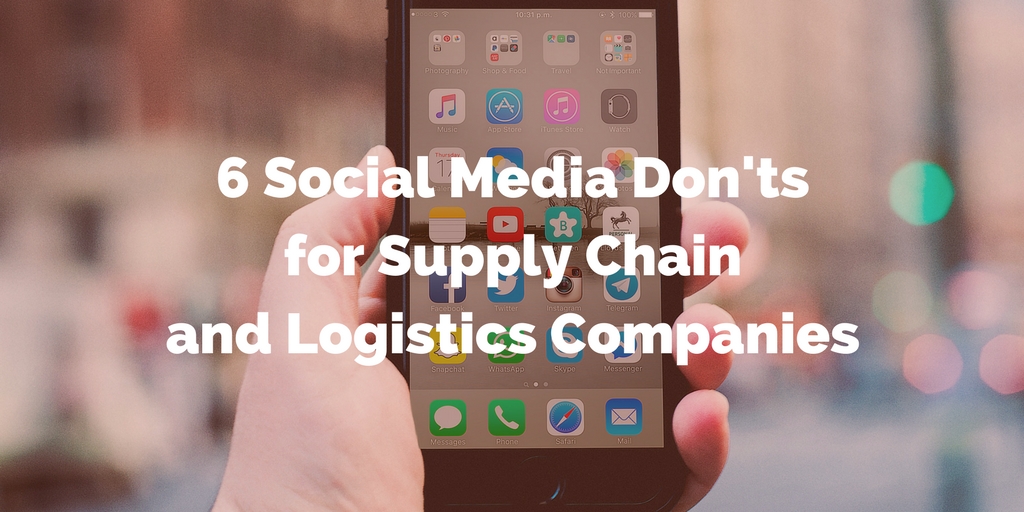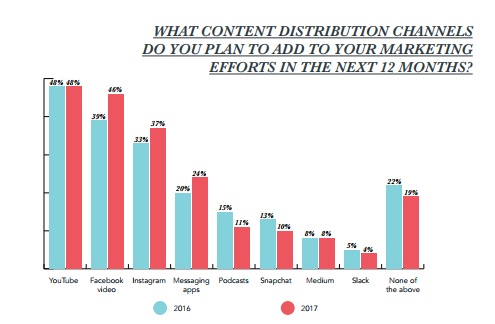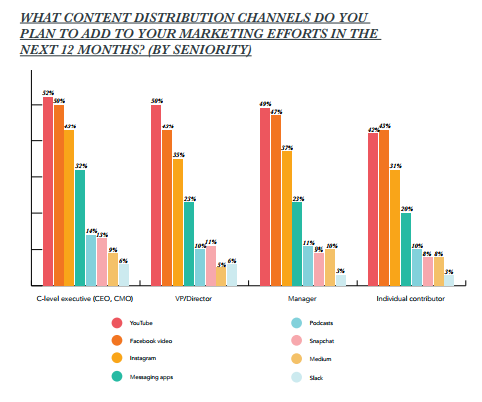
by Fronetics | Aug 23, 2017 | Blog, Content Marketing, Marketing, Social Media
In keeping with social media etiquette for businesses, you really shouldn’t do these things.
It’s easy to get bombarded with suggestions on how to interact with your customer base on social media. Amid the endless barrage of ideas for what to do, it’s worth remembering that not all social media engagement is equal — sometimes, it’s just as important to remember what not to do. (See for example #LeggingsGate.)
Let’s talk about the specifics of keeping your proverbial foot out of your business’ mouth online. Take a look at the list below of 6 don’ts for B2B businesses.
6 social media don’ts
1) Don’t assume that just because you’re online, offline rules of communication and conduct don’t apply.
It may seem obvious, but it’s all-too-often forgotten. This is a good rule, and an easy metric by which to judge any content before posting: Your interactions online should measure up to professional interactions you would have in person.
2) Don’t re-post, re-tweet, re-gram, or re-share external content without a thorough check first.
Re-posting content that’s of interest to your business’ audience is a great way to promote discussion and engagement. But don’t get sloppy. Remember that even if content didn’t start with you, if it’s posted on your company’s social media accounts, it represents your business. Make sure content is well-researched and from reliable sources. Want to re-post something controversial? Just be sure to include a disclaimer or explanation in your post.
3) Don’t forget that emotional intelligence is just as important for businesses as for individuals.
Never forget that behind every social media account is a human being. The bottom line: “bring emotional intelligence to your social media management. Take the time to address any issues with compassion and understanding.”
4) Don’t ignore comments.
Social media is all about engagement with your audience and potential customer base. Yes, responding to every comment takes time and resources, but it is well worth the effort. A comment ignored sends the message that you don’t feel that your customer’s question, concern, or observation is important. Use comments as the opportunity they are to interact with your followers, and show them that you are ready and willing to address any issues they may have.
5) Don’t delete negative comments.
Once it’s online, trust that people have seen it. Deleting a complaint will only make your business appear insensitive and evasive. Addressing negative comments demonstrates that your company is proactive about resolving issues and taking care of your customers.
6) Don’t forget the basic principals of common sense and good judgment.
This one comes from John P. David of David PR Group. It seems like another obvious one, but people and businesses violate this principle all the time. Always have at least two pairs of eyes on everything you are going to post, and anything remotely controversial should be thoroughly vetted by as many people as necessary. When in doubt, David says, don’t post.
If your company has committed any of these social media don’ts in the past, don’t panic. These platforms offer an ideal place for renewing and tweaking your image. Invest in the creation of a good social media policy. Don’t give the enormously important task of social media management to a summer intern. And, for goodness’ sakes, remember you’re a human talking to other humans.
Related posts:


by Fronetics | Aug 22, 2017 | Blog, Content Marketing, Logistics, Marketing, Supply Chain
Supply chain and logistics businesses need to be about more than themselves, and content marketing can help them get there.
While conventional wisdom tells us that content marketing is useful and important for any business, there are still some in the supply chain and logistics industries that remain unconvinced. It’s an understandable conundrum: Content marketing requires significant time, labor, and resources, and it can take quite some time to start reaping benefits.
The bottom line is that studies have shown that of companies with a documented content marketing strategy, 86% find their efforts to be successful in generating new leads, creating lasting relationships with customers, and increased ROI.
How can content marketing make my business better?
Consider this: Content marketing helps a company become more than just another business to customers — it can become a valuable resource for everything related to their products and services.
A good content marketing strategy is about understanding the questions and concerns that are particular to your customer base, and offering quality information and analysis that answers those needs. In the words of River Pools & Spas co-owner Marcus Sheridan, “The moment we stopped saying, ‘We’re pool builders,’ and started saying, ‘We are the best teachers in the world about Fiberglass pools and we just happen to install them as well,’…that was one of the most prosperous days of our lives.”
It’s worth noting that Sheridan was discussing his company’s turnaround from near bankruptcy to becoming a global leader in its field. He attributes this success to switching his company’s mission from selling its product to educating potential buyers — namely, content marketing.
Your business is more than its product.
Recognizing that your business has more to offer than its primary product or service is at the core of what content marketing is all about. Kirk Cheyfitz, CEO of Story Worldwide, puts it this way: “Like a decent human being, brands need to be about more than themselves.”
Start thinking about your business this way. You have a team of people with a tremendous aggregate of experience, expertise, and perspectives. That means that you can offer your audience far more than simply your primary product or service: You can offer them knowledge. Your audience is, in turn, far more likely to become buyers as you provide value — which builds trust and cultivates lasting, fruitful relationships.
What can I do to implement an effective content marketing strategy?
If you’re just jumping on the content marketing bandwagon, it’s an exciting time for your business. You might want to check out our Twelve-Step Guide to a Content Marketing Strategy and other resources to help you through the process.
A visual content audit is a solid first step. The main thing to keep in mind is that you have valuable resources at your disposal that you can offer your audience of potential buyers — start sharing!
Related posts:


by Fronetics | Jul 27, 2017 | Blog, Content Marketing, Current Events, Marketing, Social Media
In July’s social media news, platforms saw a rise in daily active users and broke records in more than one category.
Once thought to be a passing trend, social media is nowhere near slowing down in terms of growth. Next Web reported that India has taken over as the largest audience of Facebook, beating out the U.S. with over 241 million active users. Active users in India are up 27% in the past six months, twice the rate of U.S. users.
But the social media news doesn’t stop there. Facebook and Instagram are topping charts with their active users. LinkedIn and Google are boosting job opportunities through new features and search capabilities. And social media monitoring platforms are adding video to their repertoire.
Here’s a look at this month’s social media news.
Facebook reaches over 2 billion monthly active users around the world
India isn’t the only country boosting Facebook user numbers. The social media giant just celebrated having “2 billion people connecting and building communities on Facebook every month.” The company thanked its users with a personalized video and Mark Zuckerberg’s promise to take the global connection and use it to create a “more open and connected” world.
Instagram Stories reaches 250 million daily active users and adds live video replay
Instagram Stories continues to take over the ‘stories’ arena with 250 million active daily users. Snapchat, which founded the stories format, is falling far behind with only 161 million active daily users. Instagram Stories was unveiled last August and has experienced remarkable growth and success thanks to support from its sister company, Facebook. The social media platform has also introduced its newest feature, a share button with the ability to replay live videos for up to 24 hours.
Facebook tests custom audiences based on engagement with Instagram Business Profiles
Adweek reports that “Facebook is testing the ability for brands to create custom audiences based on engagement with Instagram business profiles.” This new type of filtering could allow brands to create engagement audiences, people who have previously engaged with your content on Instagram. Filters could include all interactions, users that have commented on a post, or any activity within a certain time frame. Though only in the testing stages, these custom audiences could help brands create specific messaging for targeted audiences based on their interactions with a brand’s Instagram page.
CrowdTangle adds video views to metrics
CrowdTangle, a social media monitoring platform for brands, has just added video views to its metrics for Facebook and Instagram. With video’s increasing popularity, the company felt it was important to offer its clients a way to measure how their videos are performing. “Publishers can now easily track emerging new trends and best practices on Facebook and Instagram, as well as discover great videos and video creators, see overall video views across their industry, and benchmark themselves against competitors,” CrowdTangle says.
LinkedIn creates new search to boost job opportunities
LinkedIn has created new search capabilities that make it easier for users to uncover new jobs and other professional opportunities. The new search also allows users to see the companies and job titles of the people who found them in a search, identifying opportunities that align with the user’s resume. Available on your phone or desktop computer, these new features make searching jobs and hiring managers that much more accessible.
Google launches Google for Jobs
Partnering with the biggest job searching sites — like LinkedIn, Monster and CareerBuilder — Google just introduced a new initiative to allow users to find job opportunities directly through a Google search. The new search update also allows users to receive email alerts of new employment postings in real time. “When Google for Jobs launches, it will act as kind of a mega job-search engine that will let you sort through multiple career sites in one go,” says Google CEO Sundar Pichai.
Related Posts


by Fronetics | Jul 25, 2017 | Blog, Content Marketing, Marketing, Strategy
When you achieve sales and marketing alignment, your company will perform better. Here’s how to get there.
The State of Inbound 2017 reports that only 22% of respondents say their sales and marketing relationship is tightly aligned. That’s a big problem.
Sales and marketing teams that are tightly aligned perform better, and revenue increases as well. Clear and consistent expectations between the two teams results in positivity across the boardroom.
Here are 6 ways to embrace “smarketing,” the process of integrating sales and marketing.
6 steps to ensure sales and marketing alignment
1. Create an agreement.
Marketing strategies are three times more effective when a Service Level Agreement (SLA) aligning marketing goals with sales team practices is in place. The SLA clearly states how each side will help one another. Some 80% of respondents with an SLA in place who feel tightly aligned report that their marketing strategy is effective. Tightly aligned marketing and sales produces higher-value marketing leads.
2. Hear it from the top.
Demonstrate the value of aligned sales and marketing across all levels of the company. C-level executives know the importance of tight alignment, and when they communicate it to managers and individuals, it will boost key players’ confidence. Shout it from the rooftops so everyone gets the message.
3. Straddle both sectors.
Create a position or positions to supervise the alignment of both fields. That person can put a plan in place with measurable outcomes, as well as mechanisms for tracking client leads and feedback. First on the new position to-do list: devising an “Alignment 101” class to train each group on expectations and processes.
4. Monitor the revenue cycle.
Develop a system to keep track of leads from inception to signing on the dotted line. Make sure both sides of the aisle can (and do) access and update lead information, allowing everyone to take ownership of business successes. Monitoring the revenue cycle keeps everyone accountable.
5. Hold meetings and calls.
No one wants more meetings added to their calendars, but a weekly or bi-weekly check in gets everyone on the same page, imperative for tight alignment. Consider listening in on sales calls and attending each other’s networking events. Have fun learning about each other’s fields and how they overlap. A fresh set of eyes on something can often lead to a positive brainstorming session.
6. Create content.
Generating content for the sales team is a helpful way to partner up. Email templates, white papers, social media content, and Q&As are all tools salespeople can use to attract the attention of potential customers. Ask your sales counterparts how you can better support them.
Related posts:


by Fronetics | Jul 24, 2017 | Blog, Content Marketing, Marketing, Social Media, Supply Chain
Sharing content from third-party sources establishes your company as a go-to resource for all things related to your industry, sector, products, or services.
When I hear the word “curate,” I think of an art gallery. I think of someone systematically picking pieces of art to display together. I think of the time and effort it takes to put these pieces together in a cohesive manor.
Curating content is no different. It is the process of finding, strategically piecing together, and sharing content that is relevant to your audience through your various distribution channels. Using third-party social media posts, blogs, videos, and more, supply chain companies can enhance their content marketing efforts by distributing information that is readily available.
Research shows content curation is a widely practice content marketing method.
- 82% of marketers curate content. (IMN Inc.)
- 83.3% of marketers curate/share content with their customers and/or prospects. (Curata)
Obviously if so many marketers are curating content, there’s a reason. Here are five benefits of content curation for your company.
5 benefits of curating content
1. Establish your expertise
By digging around industry websites or social channels to find interesting and relevant information, you are proving to your readers that you are an expert in your field. You know what’s important and where to find it. You’ll become the go-to company for the most cutting-edge content — all in one easy-to-find place (meaning your audience doesn’t have to scour the web themselves). This will increase your visibility and encourage visitors to trust you as an authority in your industry.
2. Offer a variety of content
Marketers work hard to create different types of content. From blogs to videos to white papers, everyone is trying to stand out and keep things fresh. But you may not be successful at every medium. By curating content from other sources, you can get around that. If you struggle with creating videos, for example, find a reliable source that is already successful in that arena and share with your audience. Your followers will appreciate the change in scenery and will want to come back to see what else is in store.
3. Engage with influencers
TopRank’s Caitlin Burgess writes, “By curating your influencers’ content, it can take less time to achieve your goals, such as developing a working relationship with them and borrowing their audience.” By sharing content from someone who is important and/or influential to your target audience, you can begin a relationship that can have benefits to both parties: Your audience enjoys the content, and the influencer gets free publicity (from you!).
4. Stay in the know
One of the major complaints about content curation is the time it takes to research and find reliable pieces to share. And though there are tools out there to help automate this process, there are major benefits to going through the motions yourself. You’ll not only discover content you can share with your audience, you’ll also keep your finger on the pulse of what’s going on. Consider curation part for your audience and part for you to stay educated on the news and trends in your industry.
5. Keep up the demand for constant content
The foundation of content marketing is to generate leads through the consistent creation and sharing of relevant material. Unfortunately, marketers often struggle to keep up with the demand for new content around the clock. With content curation, you don’t have to be the only one producing content. By sharing quality content from various sources, you are able to supplement your own content and publish more consistently.
Being able to identify, make sense of, and distribute relevant and helpful information makes you valuable to your customers. Over time, readers will come to know you as a trusted, reliable source of knowledge — someone who is not always trying to sell them something. You are an expert in your area of business, and you save your customers and prospects lots of time and effort distributing relevant information so they don’t have to go searching for it from independent sources.
Related posts:

by Fronetics | Jul 20, 2017 | Blog, Content Marketing, Marketing, Social Media
Recent surveys show video platforms are the next big focus for marketers in terms of content distribution channels.
Social media marketing can seem a bit like keeping up with the Joneses. Which content distribution channels are your competitors using? Where are they getting the most engagement? How often are they posting and when?
We’re big advocates of social benchmarking against your competitors. But, just as much, we are always thinking ahead, trying to figure out where the industry is going next. It’s important to get ahead of the trends so that you can be right there leading the pack.
The State of Inbound has been tracking global marketing and sales trends for the last eight years, with a particular focus on inbound marketing. (Content marketing is a form of inbound marketing.) The 2017 survey included more than 6,300 professionals at from 141 countries, so it offers a very comprehensive view of current trends in content marketing.
One part of the survey of particular interest involves which distribution channels marketers are planning to invest in next. It gives us an idea of where companies will be putting their time and money in terms of social media marketing. Let’s take a look at the results.
Content distribution channel investment
The more than 6,300 marketing professionals surveyed answered the following question: “What content distribution channels do you plan to add to your marketing efforts in the next 12 months?” The chart below shows responses from 2016 and 2017 surveys for comparison.

Source: State of Inbound 2017
Marketers will maintain or increase their investment on YouTube and Facebook video — focus on the latter jumping a significant 7% over 2016. Interest in Instagram and messaging apps has also grown significantly over the last year, while marketers’ investment in podcasts, Snapchat, and Slack has decreased.
I also want to note quickly that investment in Medium has remained steady at 8%. I plan to write more about Medium as an opportunity for supply chain and logistics businesses in the near future, so stay tuned!
Misaligned priorities
Another noteworthy aspect of this survey question is how respondents at various levels of the corporate ladder answered. Do the people who set company goals have the same priorities as those tasked with social media management and content distribution on a daily basis? Of course not! Take a look.

Source: State of Inbound 2017
Broken down by respondents’ roles, the data shows a division in the priorities of C-level executives versus individual contributors. Executives show a higher preference to expand to new channels of distribution such as messaging apps. The individual contributors responsible for the day-to-day oversight, however, offer a more conservative approach, favoring more tried-and-true distribution channels.
It is also interesting to note that individual contributors consider Facebook video a top priority slightly over YouTube, while executives, directors, and managers uniformly prefer YouTube.
Our takeaway: Video, video video
Across the board, companies are turning their content distribution focus to video platforms, and the supply chain should be, too. If you haven’t heard me say it before, I’ll tell you now: Yes, video can work for the supply chain.
Why? In a nutshell, YouTube reaches more adults ages 18-34 in the U.S. than any cable network. Users browse the platform for entertainment purposes, but also for tips, information, and ideas. And anywhere people are seeking solutions, businesses should be providing answers.
Live video, too, is a trend that is not going away anytime soon. According to the 2017 Social Media Marketing Industry Report, 61% of marketers plan on using live video services such as Facebook Live and Periscope, and 69% want to learn more about live video.
Live video helps businesses promote transparency, good communication, and relatability. It’s something that will do your business a world of good in the supply chain and logistics industries.
Related posts:












